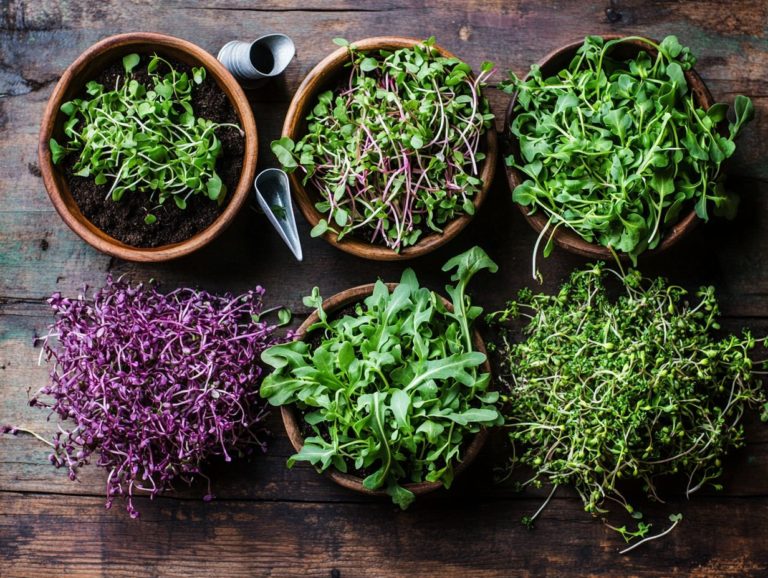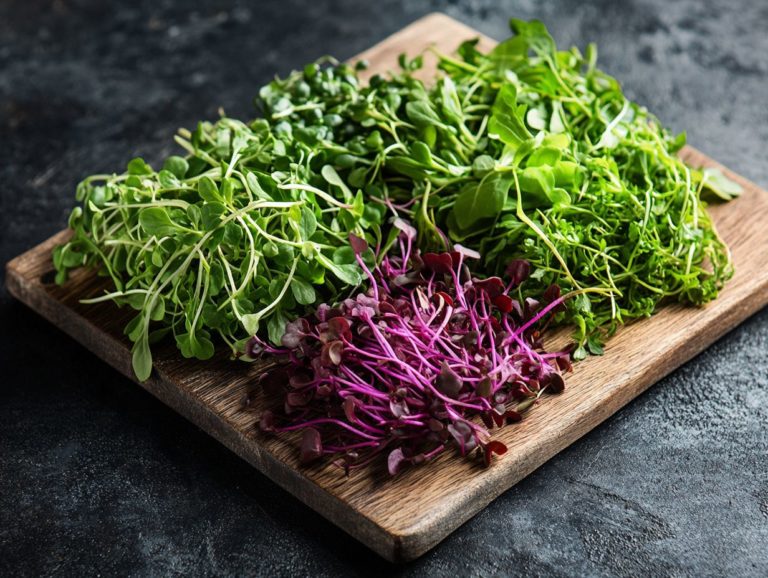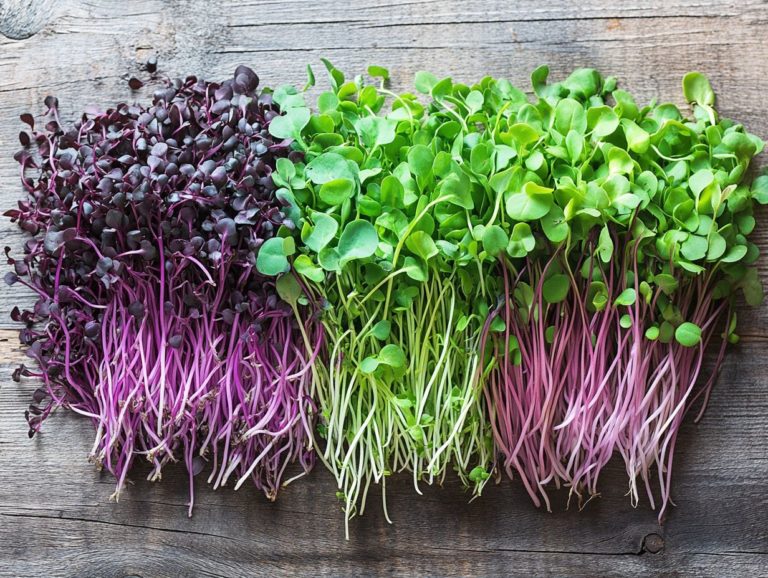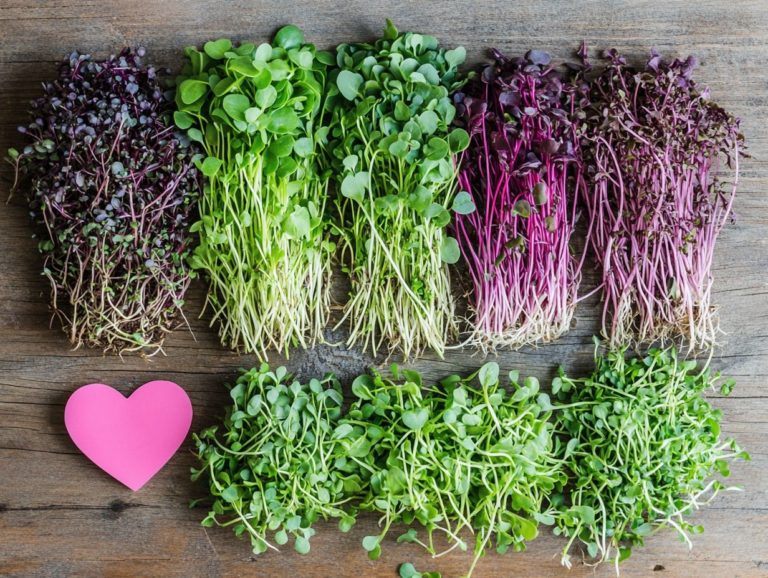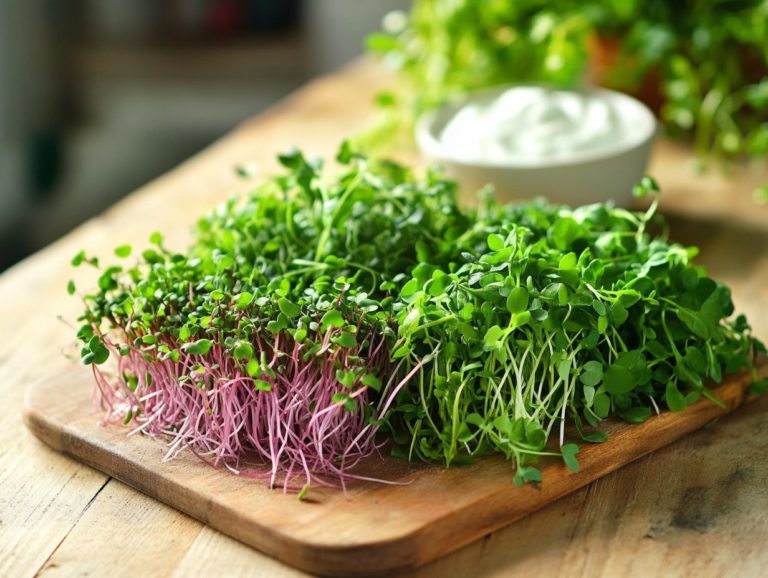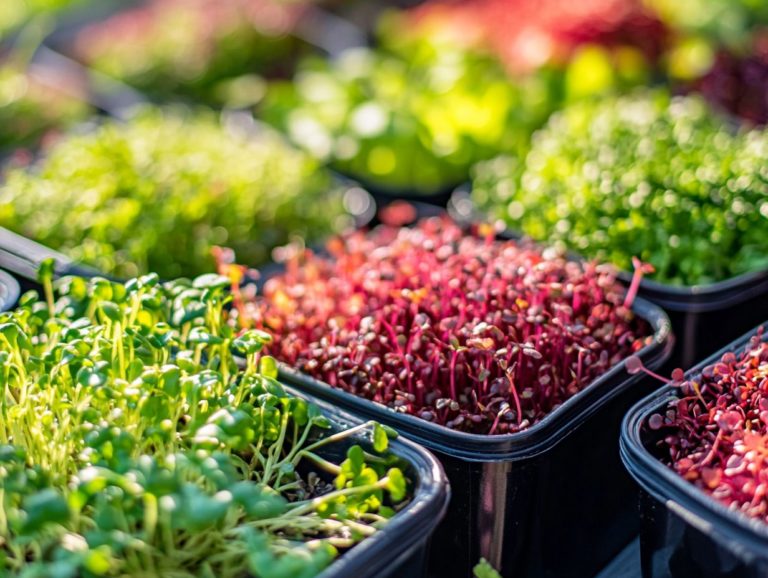5 Microgreens to Support Healthy Metabolism
Microgreens are petite, nutrient-dense plants that can significantly enhance your health, especially your metabolism.
In this article, discover five remarkable microgreens: broccoli, radish, cilantro, mustard, and arugula. Each of these greens brings unique nutritional benefits and flavors, effortlessly elevating your meals.
Learn how easy it is to add these vibrant greens to your meals! You’ll also find practical tips for growing them at home, potential side effects to be aware of, and the additional advantages of making microgreens a staple in your daily routine.
Uncover how these small greens can create a substantial impact on your health!
Contents
- Key Takeaways:
- 1. Broccoli Microgreens
- 2. Radish Microgreens
- 3. Cilantro Microgreens
- 4. Mustard Microgreens
- 5. Arugula Microgreens
- What Are Microgreens and How Do They Support Metabolism?
- How Can One Incorporate Microgreens into Their Diet?
- What Are the Different Ways to Grow Microgreens at Home?
- What Are the Possible Side Effects of Consuming Microgreens?
- What Are Some Other Benefits of Consuming Microgreens?
- Frequently Asked Questions
Key Takeaways:

- Include broccoli, radish, cilantro, mustard, and arugula microgreens in your diet to support a healthy metabolism.
- Microgreens are packed with essential nutrients and antioxidants that aid in metabolic functioning.
- Add microgreens to your meals, smoothies, or salads for a boost of flavor and nutrition.
1. Broccoli Microgreens
Broccoli microgreens rank among the most nutrient-dense foods available. They are brimming with vitamins, minerals, and antioxidants that can significantly elevate your health and well-being.
These petite powerhouses are loaded with vitamins A, C, E, and K, along with essential minerals like potassium, iron, and magnesium. They play a vital role in strengthening your immune system and maintaining your overall health.
Research shows they contain natural compounds found in broccoli that may help prevent cancer and support heart health, helping to lower cholesterol levels and improve blood circulation.
Registered dietitian Kayla Kopp suggests incorporating broccoli microgreens into your salads, smoothies, and wraps. This not only boosts the nutritional value of your meals but also enhances both flavor and texture.
2. Radish Microgreens
Radish microgreens are a vibrant, nutrient-packed addition to your culinary repertoire. They bring a delightful peppery flavor along with impressive health benefits, including a high antioxidant content.
These tiny greens are particularly noteworthy for their ability to support metabolic health by enhancing insulin sensitivity and helping regulate blood sugar levels. Incorporating radish microgreens into your meals is straightforward and enjoyable.
They add a zesty crunch to salads and introduce a fresh twist in sandwiches. For a refreshing smoothie, blend them with fruits like pineapple or apple.
This combination creates a deliciously nutritious drink that tantalizes your taste buds while helping to sustain your energy levels throughout the day. With their versatility and remarkable health benefits, top microgreens for weight loss, like radish microgreens, deserve a well-earned place in your diet.
3. Cilantro Microgreens
Cilantro microgreens serve not just as a delightful garnish but as a remarkable powerhouse of health benefits. They are brimming with vitamins and essential nutrients tailored to various dietary needs.
They shine particularly bright with vitamin K, which plays a vital role in supporting digestive health. Vitamin C is celebrated for its detoxifying properties, fostering a healthy gut environment and aiding in flushing out toxins from your body.
If you’re keen to incorporate these vibrant greens into your meals, consider tossing them into salads for a refreshing crunch. Use them as a zesty topping on tacos or soups, or blend them into smoothies for an added nutrient boost.
Their lively flavor can elevate even the simplest dishes, making them not only more enjoyable but also enhancing your overall health.
Ready to try growing your own microgreens? Start incorporating them into your meals today for fantastic health benefits, including the top 10 microgreens for nutritional boost!
4. Mustard Microgreens
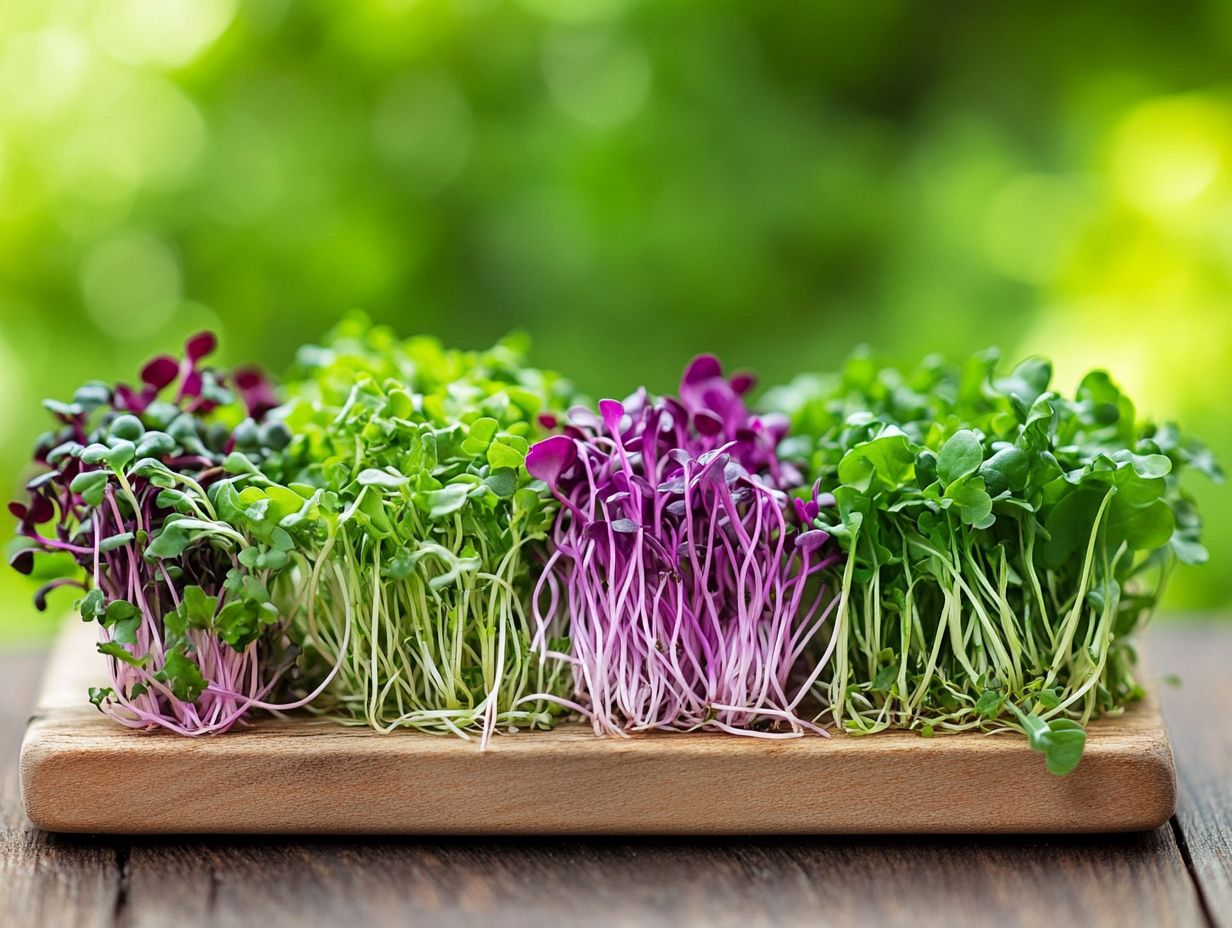
Mustard microgreens are a delightful choice, renowned for their bold flavor and exceptional nutritional value. These tiny greens are rich in antioxidants. They can elevate your meals.
Their distinct peppery essence makes them a fantastic addition to salads, sandwiches, and even as a garnish for soups. They add both taste and texture to your dishes. Not only do these vibrant greens deliver a punch of flavor, but they also possess potential anti-inflammatory properties, which can be valuable in your journey toward overall health.
Incorporating mustard microgreens into your homemade dressings can take your meals to the next level, enriching them with essential nutrients. A simple vinaigrette made with olive oil, vinegar, and a handful of these greens can create a zesty dressing that enhances any salad or grain bowl, showcasing both flavor and wellness in every bite.
5. Arugula Microgreens
Arugula microgreens are a nutrient-dense option you should consider, packed with vitamins and minerals like calcium. They make a brilliant addition to your health-conscious diet.
These tiny greens also burst with vitamins A, C, and K, all of which play crucial roles in supporting bone health and a strong immune system. Vitamin K aids in calcium absorption, while vitamin C is essential for collagen formation, helping maintain the structural integrity of your bones.
Adding arugula microgreens to your meals is easy and fun! Toss a handful into your fresh salads for an added peppery kick, or layer them into wraps and sandwiches for an extra burst of flavor and nutrients. Their versatility makes them the perfect choice for enhancing both your taste buds and your health while promoting a healthier lifestyle.
What Are Microgreens and How Do They Support Metabolism?
Microgreens are young, edible greens harvested just as the first leaves develop. Packed with nutrients, they support your metabolism through rich concentrations of vitamins, minerals, and antioxidants making them a vital addition to a healthy diet.
These tiny powerhouses can sprout from a variety of seeds, including vegetables, herbs, and even some grains. In the cultivation process, you typically sow seeds in shallow trays filled with soil or a growing medium. By providing adequate light, warmth, and moisture, you encourage rapid germination.
In just 7 to 21 days, those greens are ready for harvest, boasting impressive nutrient levels known to benefit metabolic health. Research suggests that incorporating microgreens into your diet may assist in managing conditions like Type 2 diabetes, largely due to their high antioxidant content, which helps combat oxidative stress. For a delicious and nutritious boost, consider adding 5 nutritious microgreen varieties for smoothies, with vitamins E and C present, these greens are vital for your well-being, underscoring their importance as functional foods.
What Are the Nutritional Benefits of Each Microgreen?
Each type of microgreen you choose brings its own unique nutritional benefits, enriching your diet with essential vitamins, minerals, and compounds that promote wellness.
Take beet microgreens; they are particularly abundant in vitamin A, crucial for maintaining good vision and bolstering your immune system. Then there are broccoli microgreens, renowned for their high levels of sulforaphane, a powerful compound celebrated for its anti-cancer properties. The vibrant pea shoots you add to your dishes are loaded with vitamin C, essential for collagen production and overall skin health. If you’re looking to boost your dietary iron intake, sunflower microgreens are an excellent choice, rich in iron, supporting blood health and enhancing your energy levels. For more on these nutritious options, check out the top microgreen varieties for health enthusiasts.
Incorporating these specific microgreens not only elevates the flavor of your meals but also significantly enhances their nutritional profile.
Don t miss out on their incredible benefits! Go ahead and enjoy the health benefits of these vibrant microgreens!
How Can One Incorporate Microgreens into Their Diet?
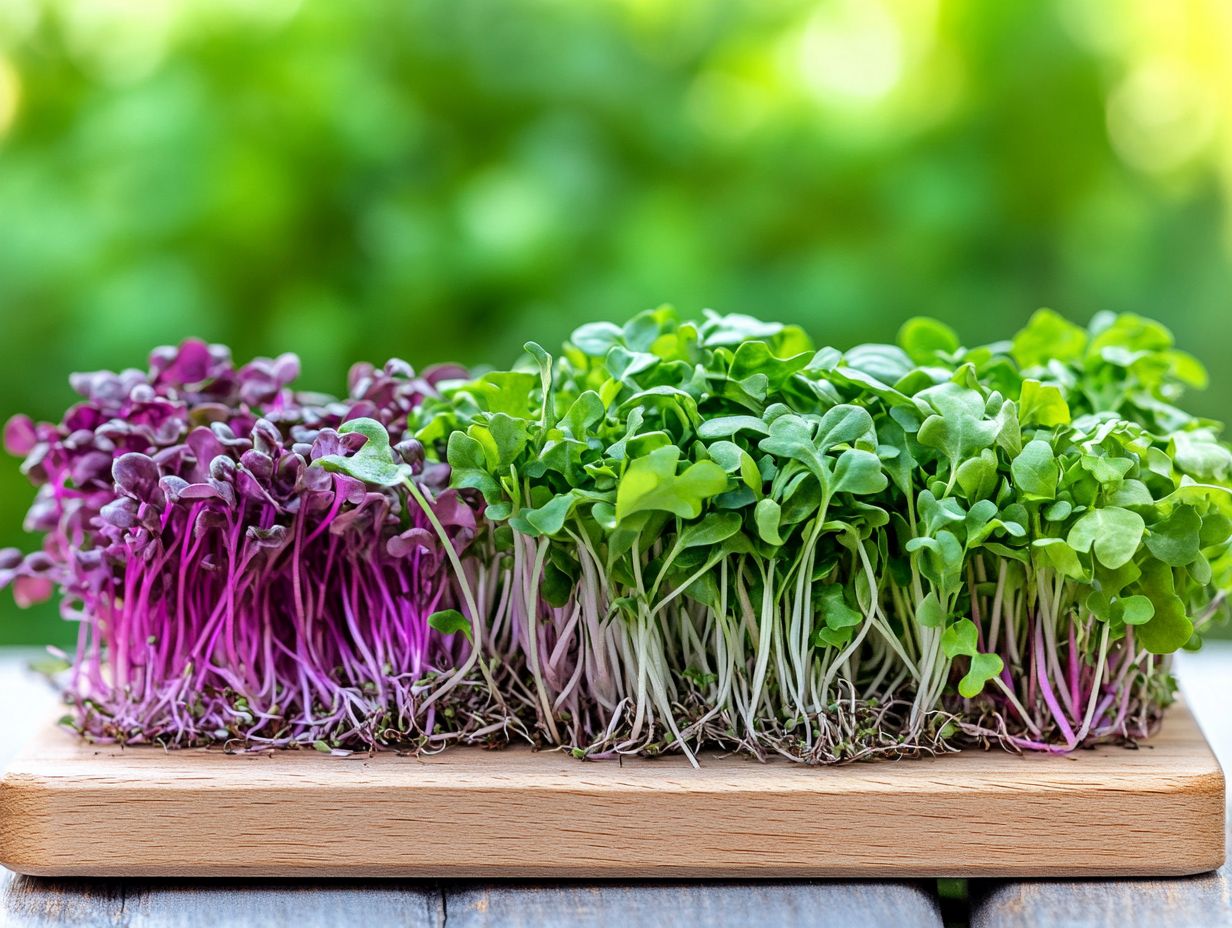
Incorporating microgreens into your diet is simple and versatile. They can elevate your meals with enhanced flavor and nutritional benefits without sacrificing taste.
These tiny powerhouses can be sprinkled over salads for a delightful crunch or blended seamlessly into smoothies for that extra nutrient boost. Think of them as stunning garnishes for your main dishes, adding vibrant color that enhances visual appeal.
Their adaptability makes them an excellent choice for plant-based meals, catering to various dietary preferences while infusing depth into diverse cuisines.
Whether you re vegan, vegetarian, or just looking to add more greens, microgreens can transform your dishes and align perfectly with your healthy eating habits.
What Are the Different Ways to Grow Microgreens at Home?
Growing microgreens at home is a rewarding and straightforward venture. You can cultivate nutritious greens that elevate your meals and promote healthy eating habits.
Explore methods like soil-based, hydroponics, and container gardening to customize your approach to fit your space and resources.
Soil-based methods use nutrient-rich soil for robust growth. Hydroponics lets you grow plants without soil, leading to faster development and higher yields. Container gardening offers flexibility, making it ideal if space is limited.
No matter your choice, home-grown microgreens will add vibrant flavors and colors to your meals while also serving as a concentrated source of vitamins, minerals, and antioxidants. For a delicious start to your day, consider the top 5 microgreen varieties for breakfast, enhancing your well-being.
What Are the Possible Side Effects of Consuming Microgreens?
While microgreens are a delightful and nutritious addition to your diet, some people might have side effects, especially if they have allergies or sensitivities to certain plants.
These vibrant greens can trigger reactions in those allergic to specific varieties, like mustard or beet greens. Be cautious; some microgreens can interact with medications, particularly blood thinners (medications that prevent blood clotting) and antihypertensives (medications that lower blood pressure). Additionally, incorporating microgreens into your diet can offer various benefits, including ways they promote mental clarity.
Moderation is crucial. Enjoying these nutritious gems can be rewarding, but overdoing it could lead to unwanted effects. If you have any doubts about allergies or potential interactions, consult a healthcare professional for personalized advice to ensure a safe and enjoyable experience with microgreens packed with vitamins.
What Are Some Other Benefits of Consuming Microgreens?
Consuming microgreens offers far more than just nutritional value; it brings a host of health benefits. These tiny greens are rich in antioxidants that may help in cancer prevention and support heart health.
Packed with essential vitamins and minerals, microgreens combat inflammation and enhance your overall cardiovascular function. Research shows that the compounds in various microgreens, including the top 5 microgreens for smoothies, can lower cholesterol levels and reduce blood pressure, making them a heart-friendly addition to your diet.
Boosting the body’s immune response, microgreens help fend off illnesses. Some studies highlight their potential impact on cognitive health, particularly regarding Alzheimer’s disease, suggesting that regular consumption may support brain function and vitality. Additionally, exploring unique microgreen varieties can introduce exotic flavors to your diet while reaping these benefits.
With their impressive nutrient density, microgreens truly stand out as a superfood deserving your attention. Don’t wait! Start adding microgreens to your meals today for a healthier tomorrow!
Frequently Asked Questions
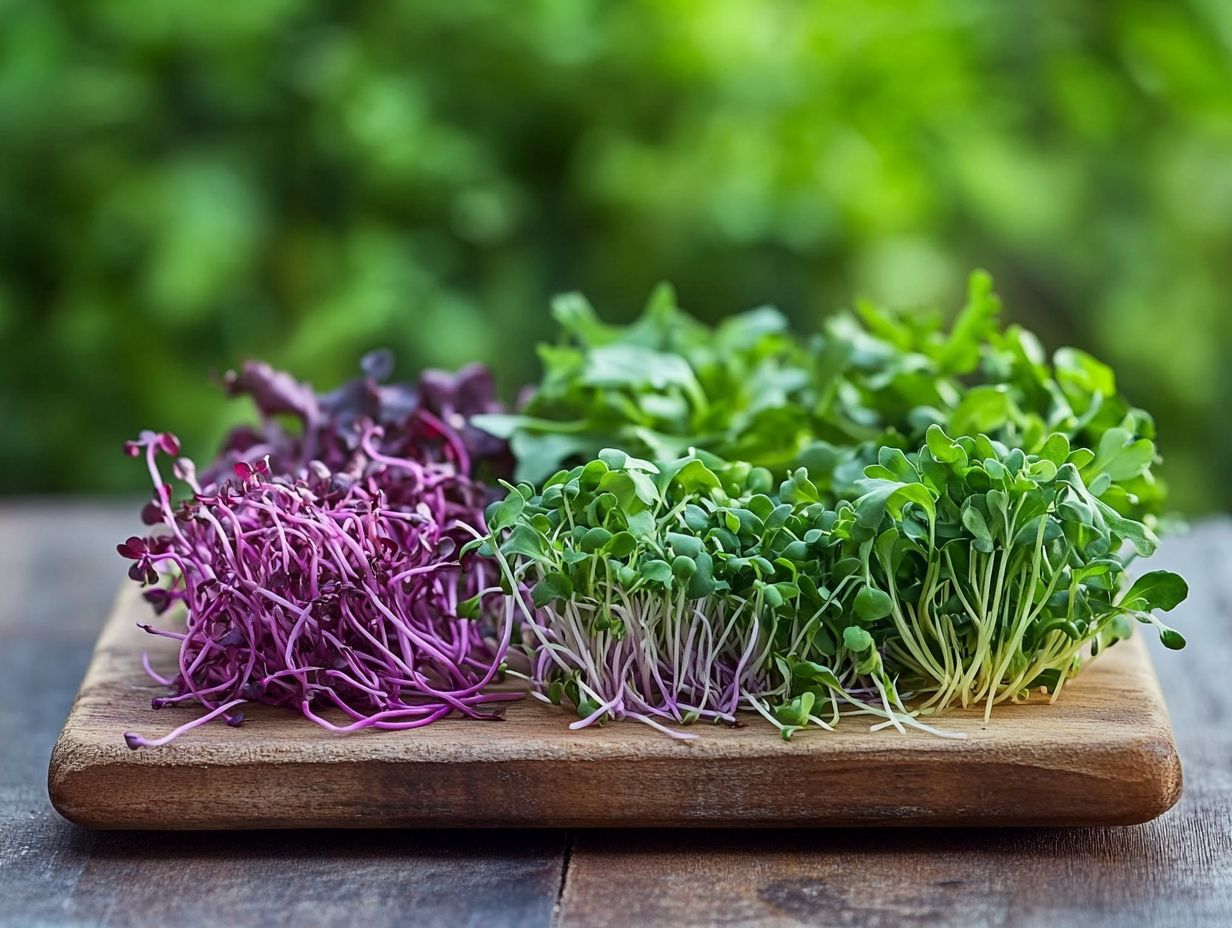
What are microgreens?
Microgreens are young plants harvested just after the first set of true leaves appear. They are smaller than baby greens but larger than sprouts, known for their concentrated nutrient content.
Try adding microgreens to your next meal and taste the difference!
How Can Microgreens Support a Healthy Metabolism?
Microgreens are packed with important vitamins and minerals that help improve digestion and boost energy. They also have high levels of enzymes that help break down food, making it easier for your body to absorb nutrients.
Which Microgreens Are Best for Supporting a Healthy Metabolism?
Some of the best microgreens for a healthy metabolism include broccoli, radish, cilantro, mustard greens, and watercress. These varieties are nutrient-rich and can enhance digestion.
How Should I Incorporate Microgreens into My Diet?
Don t miss out on adding microgreens to your meals! They re a quick and delicious way to boost your nutrition. Toss them into salads, sandwiches, or smoothies, or use them as a garnish for soups and dishes.
Are There Any Precautions I Should Take When Consuming Microgreens?
While microgreens are generally safe to eat, it s important to wash them thoroughly. Buying organic microgreens can help you avoid potential exposure to pesticides or chemicals.
Can Microgreens Be Grown at Home?
Absolutely! Microgreens can be easily grown at home with minimal space, sunlight, and water. Harvesting them fresh from your garden ensures you get the highest nutrient content.
Start your journey to a healthier metabolism today by adding microgreens to your meals!

